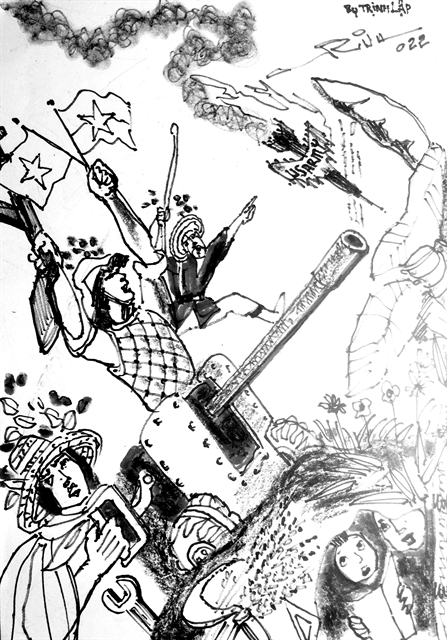 Talk Around Town
Talk Around Town

In the past few weeks, the dismantling of an old factory built by the French in the early 20th century on Trần Phú Street in the capital's Ba Đình District has caused controversy.
By Lê Hương
The demolition of an old factory built during the French colonial era in the early 20th century on Trần Phú Street in Hà Nội's Ba Đình District, which has been underway over the past few weeks, has caused controversy.
An outer wall of the building was covered with sculpted reliefs depicting a group of local self-defence force and soldiers holding their guns in combat readiness.
The caption for it was engraved: “During the American War, right here, the capital’s anti-aircraft force shot down an American reconnaissance aircraft on the birthday of President Hồ Chí Minh, May 19, 1967. The RA-5C Vigilante is the first electronic reconnaissance aircraft shot down over Hà Nội’s sky.”
The bas-relief has obviously been around for many years, though there is nothing to document its precise age.

|
| Illustration by Trịnh Lập |
Painter Lương Xuân Đoàn, chairman of the Việt Nam Fine Arts Association, analysed the relief, which he said "has simple graphics and realistic features.
“This is an artful event associated with the Hanoian’s feeling of a historical period,” he said.
Đoàn held that "what is dated yesterday should be kept for today".
Art curator Nguyễn Thế Sơn said he had tried in vain to find the creator of the art work so far.
“The relief is sculpted in a rather common style like other similar socialist realist works of the period,” he noted. "In some senses, this is a creation by a collective rather than an individual."
Nevertheless, Sơn stressed that the stone artwork still had considerable historical and cultural value.
The defunct factory will be replaced by a new high-rise building. The local authorities immediately asked the investor, the Post Equipment JSC (Postef) to keep the work in the new building.
Postef said they would move the historical artwork to a proper place or keep it in the place where it is.
“In every inch of the capital, there’s a relic valuable to someone,” said resident Nguyễn Thu Thảo.
“Archaeologists will highly appreciate it if some old object is unearthed. They may research the object for years and may raise their voice to keep the whole area for further excavation. Though it will hinder the building process.”
“We should pay a certain price for urbanisation and modernisation. Changes are indispensable to development. Though we should make change, we should keep all heritages intact.”
The same controversy was raised a few years ago when residential houses and two murals at the crossroads of Minh Khai and Bạch Mai streets south of Hà Nội were torn down to give way to a new ring road.
At the crossroads, there was a ceramic mosaic and a low relief made by painter Trường Sinh. The two works of art were on the verge of being destroyed as they were not listed as protected under the Law of Cultural Heritage.
Yet the community raised its voice, and finally, the two reliefs were moved to a park in Trần Nhật Duật Street near Long Biên Bridge. They will now act as a bridge between past and present.
Some people have suggested the investor Postef of the new building project on Trần Phú Street should keep the old outside wall with the relief attached as a wall of the new building, which would make it an interesting highlight, to say the least.
A similar feature can be found at today’s Pullman Hotel in Cát Linh Street which preserves the old chimney of an old brick factory.
“I think it’s a wise way to deal with historical artefacts,” said writer Lê Mai Thanh. “We respect the past, and the future will respect us. It will be boring if the capital city with a long history hosts only modern high-rises.”
“It will be more interesting if some part of the past remains in the present. In my newly built house, my dad decided to keep back a stone slab on the kitchen floor, which used to be in the back yard. It is the stone block on which our grandparents used to chop firewood.
“He said the stone block would help remind him and the next generation of our grandparents and the poor old days when they had to chop wood to make a fire to cook a meal.” VNS




